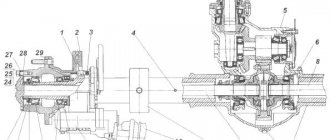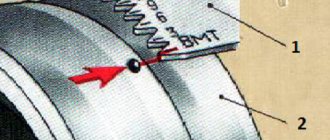When purchasing a new power source, many motorists immediately place the battery under the hood of their car, connect the terminals and begin daily use.
This can be done, but only if certain conditions are met. The battery must be relatively new and fully charged. During storage in a store or warehouse, this battery was constantly looked after and periodically connected to a charger to maintain the required charge level.
In practice, drivers do not encounter such conditions so often. Therefore, there is a need for charging and more. Caring for a new, recently purchased car battery usually involves charging and performing some additional maintenance procedures.
What you need before purchasing
First, let's talk about how to choose a car battery in a store so as not to provide yourself with a couple of extra worries. Here are some simple rules for substitution:
- Conduct an external inspection. There should be no cracks, chips or scratches on the body, acid stains, moisture or oxidation on the terminals. Any violation of integrity, tightness or sulfation means that the new battery, at a minimum, was not stored correctly. All markings and text on the label must be easy to read.
- Decipher the date of manufacture. On average, a car battery with filled electrolyte can be stored in a warehouse for an average of one year (low antimony ones less, calcium ones longer), but it is better to look for one that is no more than six months old (this is especially true for hybrid ones). This way there is less chance that in a store or warehouse it could be damaged during storage, and it did not have time to discharge. Do not delude yourself and think that the seller conscientiously maintained the charge at the optimal level from the moment the battery arrived from the warehouse.
The date of manufacture is encrypted in the markings on the lid or label. Its decryption is a frequent headache for buyers, because each manufacturer selects the cipher to suit its technical needs. It is better to ask the seller how the marking of the new battery is deciphered, since the store must keep track of the dates. Also, look for information on how to read the production date on the manufacturer’s website.
- Check voltage. We determine the level using a multimeter and a load fork, which should be in every decent store. If neither one nor the other is available or they require money for checking, it is better to look for the device elsewhere.
Set the multimeter to DC mode and touch the probes to the terminals. It is very good if the screen displays a value of 12.7 V (100% charge). It can be a little lower, the main thing is that the voltage does not drop below 12.5 V (80% charge), but this can also be fixed - you can always replenish the charge, which is what we will do below. Completely discharged batteries with a voltage of 12.0-11.9 are definitely not worth buying - they were in complete discharge conditions and most likely have already lost part of their capacity.
Using a load fork, first measure the voltage without load. It should show the familiar range of 12.4-12.7 V. Then we check the voltage under load. If it produces 9 V, then this is a good sign. If the value is lower, the battery does not support the load. Maybe a full charge cycle will help her, maybe not.
- Check the warranty card. The warranty on the original battery should not be less than one year. As a rule, the manufacturer gives a 1-2 year guarantee of uninterrupted operation.
You can also use a hydrometer to measure the density of the acid solution if the battery is serviceable and its filling holes can be opened. It is optimal if in each cell it remains at a level of 1.27 g/cm3. Readings of 1.26-1.22 g/cm3 indicate that the battery does not have enough charge.
If no problems can be identified, then you can safely take a new battery. Now we come to the main topic of the material.
Operating rules
Now we need to talk about how to properly start using your new battery and what you should know about it.
Quite often, motorists are faced with situations where a relatively new battery fails in a short period of time and requires replacement. In general, the average battery life is 3–4 years. Therefore, changing power sources at intervals of 1–2 years is definitely beyond the norm.
The reason usually lies in the fact that drivers simply do not know how to operate a new battery recently purchased for a car. And this leads to corresponding consequences.
So that this does not affect you specifically, you need to learn not only about commissioning, but also about caring for a new starter battery, designed for long and effective service for the benefit of the car:
- Choose a battery that fully complies with the requirements of the car manufacturer. This applies to capacitance, starter current, polarity. No one can give better advice than the manufacturer on this matter.
- Before putting it into operation, remove the packaging, thoroughly wipe the housing, inspect its condition, check for cracks and signs of damage.
- If this is a serviceable type, you should unscrew the plugs, thereby checking the level and density of the electrolyte. Normally it is 1.27–1.28 g/cm³.
- Check the voltage at the terminals. If it is below the permissible standard, connect the battery to a charger.
- Strictly observe polarity when connecting the battery to the on-board power supply.
- It won't hurt to periodically train a new battery. The essence of the training cycle is to discharge and then charge the battery to optimal values, repeating the procedure 2-3 times.
- Train yourself to use only high-quality distilled water. Moreover, it is better to buy it at a pharmacy, since car dealerships and gas stations often sell counterfeits. This is regular tap water or filtered drinking water. It cannot replace a full-fledged distillate. Such water will quickly damage the battery, even if it is new.
- After making your first trip with a new battery, take control voltage measurements at idle and with the engine off.
- At least once a month, clean the battery case from dirt, dust, and moisture.
- Monitor the condition of the electrical wiring, monitor the electrolyte level, and look through the charge indicator eye once a week.
- Do not allow the battery to become over-discharged. This is especially true for calcium batteries.
- Check the tightness of the terminals and terminals on the battery.
By following the rules for putting a new battery into operation, you will be able to get the maximum benefit from the battery, work out its full life, and also minimize all kinds of problems in the future. But for this you will need to continue to follow all the recommendations.
Should I charge a new battery after purchase or not?
If there is no damage, and the multimeter shows a stable voltage of 12.6-12.7 V, then there is no serious reason to charge a new battery before installing it on the car, but no one can forbid you from doing this - if you think that prevention would not hurt, feel free to connect battery to the charger.
Charging after purchase is necessary if you were sold an uncharged battery. Unfortunately, this is possible even if you checked the charge on a multimeter while still in the store - there are many tricky ways to sell stale goods. The seller, knowing that the battery had been idle for six months without recharging, could connect it to the network for a couple of minutes, and then show the buyer a multimeter with a voltage of 12.7 V. And he would find a modest 12.1 V at home if he decided to double-check the charge level. Here you will have to connect the battery to the network in any case.
In addition, a new battery should be charged if the density is below the indicated 1.27 g/cm3 - this means that the battery is approximately 20% discharged. Modern models that do not require maintenance do not always have the opportunity to open the jar and measure the electrolyte, but if such an opportunity is available, be sure to use it and bring the charge level to 100%.
If you do not charge a dead battery before installing it in a car, problems may begin. The generator is not always able to charge a new battery to 100% due to the huge number of electrical appliances that it also has to service (air conditioning, stove, control board, etc.). It is especially difficult for them when it’s winter. As a result of undercharging, the plates will begin to crumble under the influence of sulfation, which will cause a short circuit. There is a risk of sulfate formation even at 12.4 V.
First start of the battery
When using the power supply for the first time, you do not need to follow any special rules. In fact, all produced batteries are already ready for use. But how they were stored and for how long is a question, so it would be a good idea to check the voltage to understand the degree of discharge. After recharging, all that remains is to correctly place the battery in the socket, connect the terminals, making sure the contact is secure, and you are ready to go.
Installing the battery on the car.
There are car owners who charge a “fresh” battery to the maximum, if necessary, and then discharge it. This is done when you want to make sure that the declared characteristics correspond to reality, but this requires equipment for measuring energy intensity.
How to do it right
Be sure to charge a new battery if its voltage is below 12.5 V. Your goal is to use a stationary charger to bring the charge level to 100%.
Always use only proven devices, such as Kedr, Katun, Polyus Auto, Orion or Autoelectrics. You should not trust old Soviet chargers, whose service life has long expired. It is better to charge a new battery in a specially equipped garage, rather than in a residential apartment. Wear safety glasses and rubber gloves to protect yourself from sulfuric acid, which serves as the electrolyte in lead-acid batteries.
If you have an automatic charger, then no difficulties should arise here; it will automatically determine all the necessary values for the new battery. We simply connect “minus” to “minus” and “plus” to “plus”, activate the charging mode and wait for the process to complete.
With a manual charger everything is a little more complicated:
- For serviced batteries, immediately unscrew the lids of the cans and measure the electrolyte level. If there is not enough distilled water, then topping up the deficiency is required.
- We install “crocodiles” on the contacts “plus” to “plus”, and “minus” to “minus”. Do not reverse the polarity, connect carefully.
- Turn on the charger and set the current on the ammeter to 10% of the capacity (for example, for 60 A/h this is 6 A). A serviced battery will have to be charged by decreasing the current as the voltage increases.
- For maintenance-free models that do not have the ability to open cans and assess the condition of the liquid, you will have to set a constant current strength at 2 A, but no more, in order to prevent strong boiling.
- When the electrolyte begins to boil, measure the voltage - it should fluctuate at 14.5 V. From this moment, we reduce the current to 3 A, but do not turn off the charger. The higher the voltage at the terminals, the lower the current will need to be set.
- When the multimeter shows a stable 16 V, the ammeter will read 2 A. At this stage, charging the new battery can be completed. In total, 12-14 hours should pass for serviced batteries and 4-5 hours for unserviced ones. If there is a charge indicator on the side of the device, this will greatly facilitate the whole process.
- Don’t rush to screw on the lids of the jars right away, let the battery “settle” a little.
Charging a new maintenance-free battery
If you purchased a maintenance-free battery, it is recommended to charge it using a method where the voltage is constant. Thanks to this method, the electrolyte inside the battery does not heat up as much.
For a maintenance-free “battery,” it is best to use a charger equipped with a charge level indicator and the ability to automatically regulate U.
After an hour of charging, the battery capacity is restored by more than half (if its value was initially much less than that stated by the manufacturer). And after 3-4 hours you can increase the capacity level to 90 percent or more.
In general, it takes about five hours to charge a maintenance-free battery. If the charger is equipped with an indicator, it will always notify you when the process is complete.
What's next?
You can install the battery yourself or use the services offered by many stores.
Employees will check the car for current leakage and place the battery under the hood. If there are no problems starting the engine, the starter works flawlessly (everything goes smoothly and without jumps), then the task was completed perfectly. Do not forget to pick up the warranty card - you will need it if a manufacturing defect is discovered during operation.
In the future, in order to ensure a long and fruitful service life for a new car battery, you should adhere to several rules:
- Regularly monitor the cleanliness of the case, as dirt and moisture are an additional source of self-discharge.
- Make sure that the charge of the car battery does not fall below 30% and do not allow complete discharges. To do this, you either need to regularly drive without frequent stops for 40 minutes or more, or once a week you need to arrange such long trips for yourself to allow it to gain charge. One of the main factors in the deterioration and rapid failure of rechargeable batteries is short trips “to work and home” and frequent deep discharges.
- The main cause of deep discharges is prolonged listening to music with the engine not running or leaving the headlights on at night.
- Check the tightness of the terminals and clean them from sulfates - loose connections with plaque can become an additional source of short circuits and breakdown of the new battery. Before tightening, lubricate the contact areas with grease or cyatim.
- For serviced models, it is important to open the cans every 1-2 months and check the electrolyte level. Filling with distilled water is a mandatory element of care. Otherwise, the appearance of sulfates is inevitable, from which only desulfation can save you.
- Choose only high-quality wires for “lighting” with a thick cross-section and “crocodiles” that can ensure reliable contact. Wires of questionable reliability are the main cause of burnt-out terminals when starting the engine.
- If the battery has to be removed and stored outside the car, then it can only be kept in a cool, dry room at a temperature of 5-10 ° C, away from heating devices and direct sunlight. It is better to leave it “idle” for no more than a year, recharging it monthly.
- If you were completely discharged and had to “light up” from another car, then be sure to recharge the battery to 100%.
Let's sum it up
So, there is not much difference in how to charge a new battery. Whether a new car battery needs to be charged can be determined based on the voltage readings already given above. If you find yourself the owner of a new battery, which for one reason or another has already lost part of its resource (for example, due to improper storage or operation), such batteries are charged as usual.
Often, after purchasing a new battery, motorists ask when the battery should be charged for the first time. To determine if the battery requires it, always check the voltage readings. Remember that the battery may need the first charge earlier than you expect: for example, when climate conditions change, as well as when there is an unplanned overuse of internal resources.
To avoid having to charge a new car battery too early and often, follow a few simple recommendations:
- After your first ride comes to an end, immediately measure the voltage. When checking, the vehicle must be idling and the vehicle's power consumers turned off.
- From time to time, do not forget to inspect the battery for possible mechanical damage and accumulation of dust and dirt, and regularly remove dirt.
- Check the vehicle terminals to avoid oxidation, and ensure that the housing and outlet openings are sealed.
- If you “light” your car from another, do not allow the wiring to burn out , turn off the ignition.
- Check the working condition of the relay regulator and the car generator once a month. This will help avoid force majeure situations with the battery.
- Regularly measure the battery voltage , do not miss its critical drop to 30%.
To make your new battery last much longer, be careful and handle it with care and precision. If you are not sure that you can handle the battery maintenance yourself, contact a service station.
Battery cost
Among the numerous manufacturers of car batteries, there are several companies that are popular among car enthusiasts.
- The German company Bosch produces durable and high-quality devices that can work in different conditions. At the same time, most models have safety power in case the oil in the engine freezes due to severe frost. The units cost from 5,500 (model S4 005) to 25,000 rubles (battery 0092S5A150).
- The Japanese company Panasonic offers motorists inexpensive but high-quality batteries. For example, a Panasonic battery for a car model N55B24L costs 3,700 rubles.
- Batteries from the Turkish company Multu are distinguished by European quality and durability. Moreover, such a battery can be found in almost any store; such availability and the absence of negative reviews from car enthusiasts make Multu batteries optimal when choosing a “battery”. The cost of devices ranges from 3,500 rubles to 7,600 rubles.
- The Russian company Ultimatum (AKOM plant) is actively involved in the production of car batteries. The plant mainly produces batteries for cars with a Start-Stop system, as well as for vehicles with high power consumption. An Ultimatum battery for a car from a domestic manufacturer costs about 8,000 rubles.
- The American-Korean company Medalist offers car owners batteries that are “average” in terms of popularity and number of negative reviews, costing from 5,000 to 9,000 rubles.
How to properly recharge the battery
“Chargers” convert alternating current into direct current, which is why they are also called rectifiers. Such devices are usually equipped with an adjustment switch to allow charging at 12 or 24 volts. In addition, current and voltage regulators are installed on the rectifiers. When you charge a 12-volt battery, the “charger” should produce a voltage in the range of 14-14.5 volts, since otherwise you will not receive a 100% charge. Regardless of power and configuration, all rectifiers are equipped with an electric drive with a plug, converter and two output wires (plus and minus).
If we talk about the features of battery charging, then you should pay attention to the following parameters that will help you decide how to properly charge a car battery:
- The optimal current for charging a battery is 10% of the rated energy capacity of the battery. For example, if the battery rating is 60 Ah, then the current should be no more than 6 A.
- The voltage at the charger terminals should be +10% of the rated battery voltage. For example, a 100% charged “battery” has a voltage at the terminals of 12.6 V. 10% of the rated voltage in this case will be 1.26 V. Accordingly, we add this value to 12.6 V and get the best voltage equal to 13.86 IN.
- In order to quickly charge the battery, the current should be about 20-30 A. But, it is worth considering that this type of charging has a detrimental effect on the battery, so it is better not to use this method often.
- If you charge a gel battery, be sure to monitor the voltage, the critical value of which is 14.2 V for a battery of this type.
These recommendations will allow you to properly charge the battery without damaging it.











